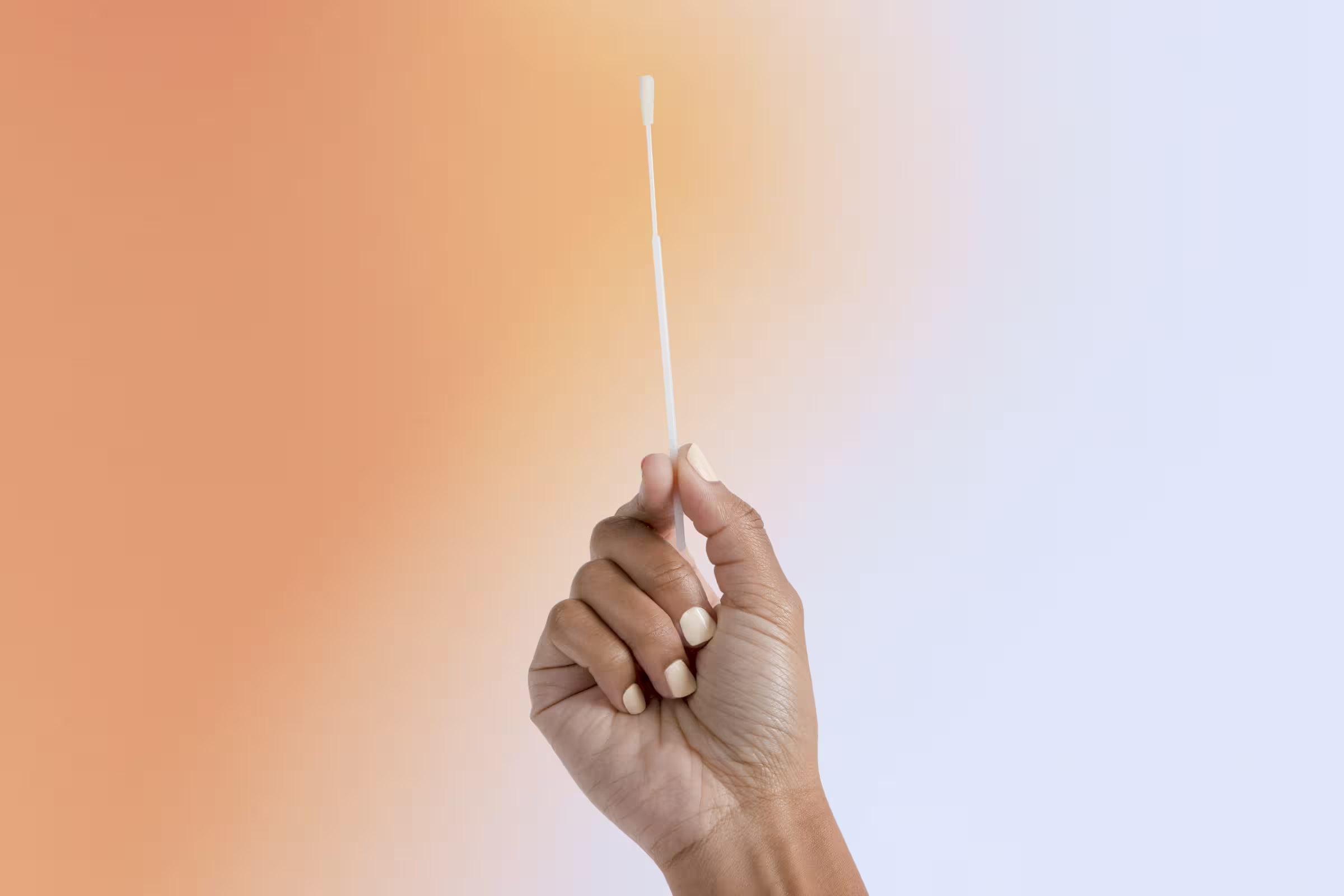

What Does a Vaginal Swab Test For?
A vaginal swab can provide essential information about your vaginal health. But what exactly does a vaginal swab test for? Find out more.
Words by Olivia Cassano
Scientifically edited by Dr. Krystal Thomas-White, PhD
Medically reviewed by Dr. Sameena Rahman, MD
A vaginal swab test is one of the most common tools used by healthcare providers to assess your reproductive health. Whether you're visiting your doctor for routine care or because you're experiencing recurrent symptoms like discomfort, abnormal vaginal discharge, or a fishy odor, a vaginal swab can provide essential information about what's happening down there. But what exactly does a vaginal swab test for? Well, the short answer is that it depends on what you're looking for.
What is a vaginal swab test?
A vaginal swab involves inserting a cotton swab into the vagina to collect a sample of cells and fluids. This sample is then sent to a lab for evaluation, where it's tested for a range of conditions.
Vaginal swab tests are usually quick, painless, and performed during a routine pelvic exam, or they may be done at home if you're using an at-home testing kit.
These tests are valuable for diagnosing infections, understanding symptoms like abnormal discharge or odor, and checking for imbalances in your vaginal microbiome. Depending on the type of test used, your doctor or testing service can detect anything from yeast infections and bacterial vaginosis (BV), to sexually transmitted infections (STIs), to broader insights about your vaginal microbiome.
What does a vaginal swab test for?
It all depends on what you’re looking for, and what technology is used to analyze the swab. A standard vaginal swab can be used to test for:
- Bacterial vaginosis: Bacterial vaginosis is a bacterial infection that occurs when the normal balance in the vagina is disrupted, leading to an overgrowth of certain bacteria. It’s the most common cause of unusual vaginal discharge and fishy odor in women.
- Yeast infections: Caused by an overgrowth of Candida, yeast infections can cause itching, burning, and a thick, white vaginal discharge.
- Sexually transmitted infections: Swab tests can detect STIs like chlamydia, gonorrhea, and trichomoniasis.
- Other bacterial or fungal infections: In some cases, a swab can identify less common vaginal infections, like cytolytic vaginosis (CV) and aerobic vaginitis (AV).
That said, not all vaginal swabs are created equal. The technology used to analyze the swab directly impacts the comprehensiveness and accuracy of the test. This is because the technology determines how many bacteria and fungi can be examined at once, as well as which types of bacteria or fungi can be accurately tested for.

Recurrent symptoms? Get Evvy's at-home vaginal microbiome test, designed by leading OB-GYNs.
The three main types of sequencing technology for vaginal microbiome tests are PCR, 16s, and metagenomics:
- PCR tests are highly accurate for detecting specific organisms, even at very low levels. But they’re limited to the specific microbes being tested for, and can’t provide a full picture of the entire vaginal microbiome or compare the number of different microbes.
- 16s is more comprehensive than PCR but only detects bacteria, not fungi (like those causing yeast infections). They can only analyze one part of the genome, making it less accurate in distinguishing between bacterial species.
- Metagenomics is the most comprehensive technology for analyzing the vaginal microbiome. It identifies all bacteria and fungi, and can even discover new microbes not being specifically searched for. It’s best suited for getting a full picture of the entire vaginal microbiome, unlike PCR, which targets specific microbes.
This is where advanced technologies, like Evvy’s Vaginal Health Test, come into play. Evvy offers the option to add an Expanded PCR Panel to our metagenomic Vaginal Health Test — so you can get the best of both worlds. Evvy’s Vaginal Health Test can detect the presence of over 700 vaginal bacteria and fungi, along with four of the most common STIs and antibiotic resistances with just one swab.
How does sequencing technology affect what a swab can test for?
Traditional vaginal swab tests often use basic microscopy or cultures to identify infections, which can miss subtle or low-level imbalances in the microbiome. Evvy’s Vaginal Health Test utilizes next-generation sequencing (NGS) technology, which takes the test to the next level by sequencing the DNA of all the microorganisms present in the vaginal sample.
Here’s how this advanced technology changes what a swab can reveal:
- More accurate results: Traditional tests may only identify a handful of bacteria or yeast that can be cultured in a lab. NGS, on the other hand, can detect the DNA of all microorganisms, even those that are present in small amounts or are difficult to culture. This means that even subtle imbalances or rare microbes are detected, giving you a more comprehensive view of your vaginal health.
- Personalized insights: By sequencing the entire vaginal microbiome, NGS can help pinpoint imbalances that are unique to you. This is important because every woman’s vaginal microbiome is different, and what’s "normal" for one person may not be for another. Evvy’s test provides detailed insights into your personal microbiome and how it may be linked to symptoms or conditions you’ve experienced.
- Targeted treatments: With detailed information about your microbiome and any pathogens present, your healthcare provider can recommend more targeted treatments.
FAQ
What diseases can be detected by a swab test?
A swab test can help detect a variety of diseases and infections, depending on the area being tested and the type of swab used. For vaginal swabs, common conditions that can be identified include bacterial vaginosis, yeast infections, and sexually transmitted infections such as chlamydia, gonorrhea, and trichomoniasis. In addition, swabs can detect respiratory infections like COVID-19, the flu, and strep throat, as well as skin or oral infections, depending on where the sample is taken.
What is the difference between a swab test and a smear?
A swab test and a smear are both ways to collect samples from the body, but they have different techniques and purposes. A swab involves using a cotton-tipped applicator to collect cells or fluids from areas like the vagina, throat, or skin. It's commonly used to check for infections like bacterial vaginosis, yeast infections, STIs, or respiratory illnesses such as COVID-19 or strep throat. The sample collected is sent to a lab for analysis to test for specific bacteria, viruses, or fungi. On the other hand, a smear, often referred to as a Pap smear, is a procedure where cells are gently scraped from the cervix using a small brush or spatula. These cells are then spread on a slide and examined under a microscope to check for abnormalities that could indicate cervical cancer or precancerous changes. Smears are mainly used for cancer screening rather than for detecting infections.
Is bacterial vaginosis an STD?
No, bacterial vaginosis isn't considered a sexually transmitted disease (STD). It happens when there's an imbalance in the natural bacteria in the vagina, which leads to an overgrowth of certain bacteria like Gardnerella vaginalis. While BV itself isn't an STD, it can be affected by sexual activity. Having new or multiple sexual partners may increase the risk of developing bacterial vaginosis, but it can also occur in women who aren't sexually active. Bacterial vaginosis is different from STDs because it isn't caused by a specific pathogen transmitted through sexual contact. It's more related to changes in the vaginal environment and the balance of bacteria. If left untreated, bacterial vaginosis can increase the risk of contracting STDs, but it's not a sexually transmitted infection itself.





